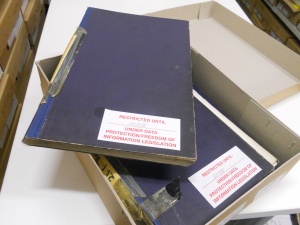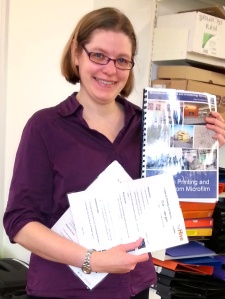As we near the end of our traineeship we are busy completing projects, thinking about all we have learnt on our placements, and applying for new jobs. My last few projects at Worcestershire Archive and Archaeology Service are a hand over pack for my absent voter project, photographs for the Explore the Past leaflet I have designed and a project to catalogue and care for the Kinver archaeology Collection.
The Absent voters from 1918 are being transcribed by a loyal band of volunteers I recruited and trained. I have supported them as they completed the work and congratulated them as they finished one book and moved to the next. But they in turn have supported me as I wrote up the project for my PG cert assignment. Now the volunteers know what they are doing I just need to leave a pack for my colleagues who will take over supervising the project.

A photograph of Sarah with volunteer David Bonnick taken by David Tyrell – for the Explore the Past leaflet
Meanwhile I have been running around trying to rope in photographers and models for some photographs to advertise the service. The staff and volunteers at WAAS, their children, and some students from the university as well as Tom from the Cathedral library, all kindly helped by posing for photographs, and I was lucky to find two very talented photographers to take the pictures. I have been researching and writing the leaflet for months, so it’s been lovely to get the last bit completed, and now it’s on the way to the printers.
And the archaeology project has given me a chance to learn more about the Heritage Environment Record, and to input items into it, while learning some more about archaeology. At the same time I have reinforced some of the skills I have previously learned in archival care and conservation, finally getting my head around how to make boxes to fit the archives.
It’s a little sad as each individual trainee departs on their new journey, but great for the project to revel in our success and I am really looking forward to my own new roles as I continue to apply all that I have learned here. I feel really lucky to have had this opportunity to work with so many experts at WAAS, and to be leaving the role to continue working within heritage.
Sarah Ganderton















